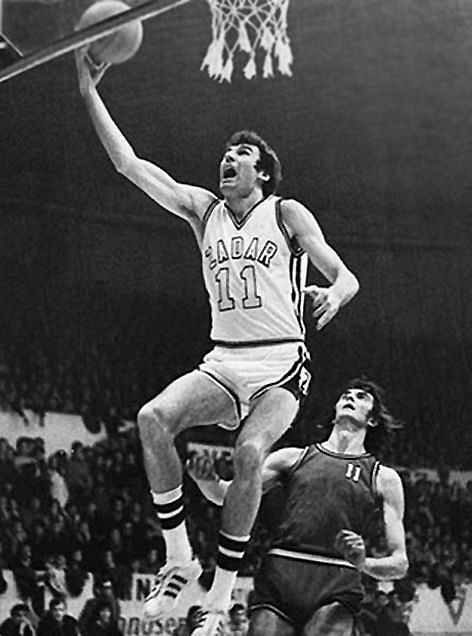
NBA Draft History: Drafted twice but never played - The legend of Kresimir Cosic
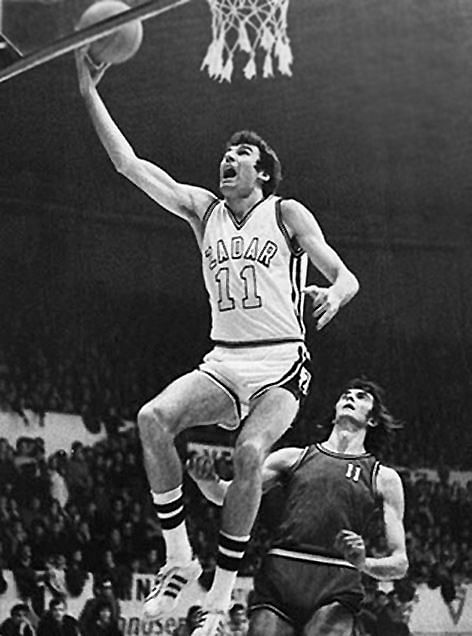
Kresimir Cosic died on May 25, 1995, in Baltimore, Maryland. He was only 47, but in those 47 years, he lived ambitiously enough to become a legendary person in the world of basketball for Brigham Young University, and especially in the republics that once made up Yugoslavia.
Kresimir (Kreso) Cosic was a sensational player and coach who had a bigger impact on the sport of basketball than most. If you were fortunate enough to see Cosic play live or on television you would have seen a thin 6'11 player that rebounded everything, protected the rim similar to Bill Russell but could pass like some of the best guards around and knock down shot after shot from mid-range.
He was way ahead of his time with his overall versatility and later on was labeled as a "stretch five". He was one of the first centers in college basketball and international play that started coming out of the paint, and it was not strange to see him on the perimeter directing his teammates like a point guard for whatever play or offense they were running.
And the unique thing about Cosic was he wasn't doing it because some coach asked him to - he was doing it because he understood the game better than most. Whatever he did had a reason and it made sense. His logic and intelligence for basketball was seen as revolutionary to many in the basketball world.
He was what most head coaches want out of their players - to be an extension of them on the court. Because of this quality Cosic was a great overall talent. All the teams he played for from age 16 in 1964, when he made his debut with Zadar, on to his career at BYU and then into his retirement at age 35 with Cibona in 1983, he was always the player that had the best impact.
Like Bill Russell did with the Boston Celtics, Cosic was also a player-coach, but he was a player for one team and coached another team in the same league during the same season. Yes, he actually did this and would drive 7-8 hours one-way by car to do it.
Like other great players, Cosic could be very impulsive and this impulsivity could betray him at times. He would explode with anger towards himself, teammates or like we see often in professional basketball - at the refs.
Usually, within a few seconds, he was a very calm and stoic player not being rattled at all by a hostile crowd. Cosic had huge hands and a knack for great timing on rebounds. Most of the time he would just pull the ball in with one hand like a giant grizzly bear pulling a beehive down from a tall tree.
Unlike a grizzly bear though, Cosic would launch the ball down the court to start a fast-break. He played with his mind and excellent skills to overcome stronger and more talented players. Like Kareem Abdul-Jabbar, he also effectively used a defenseless sky hook to score against big rim protectors and hard fouls.
And if he got tired of battling in the paint, he would simply start to move to the outside and swish jumper after jumper. The great Italian center Dino Meneghin has confessed several times that Cosic was one of the best he ever encountered in his career. To quote Meneghin:
"To me, he was the first player ever, including the NBA, who could play all five positions."
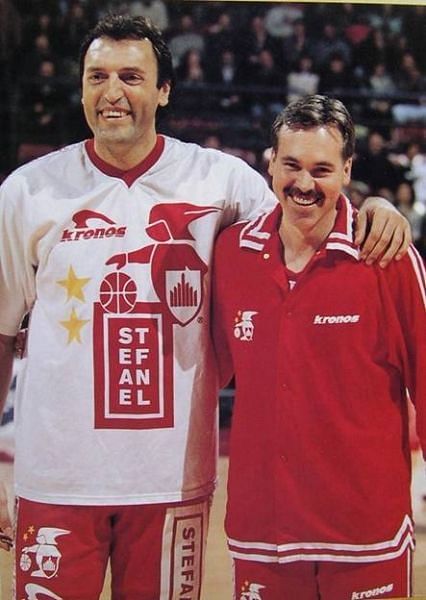
Cosic aged 16 started for his hometown Zadar's professional team. Zadar, a city on Croatia's Dalmatian coast, has a long basketball tradition that has produced many great players over the years. Cosic rose to legendary status quickly playing with another Croatian legend in Josip Gyergya.
The two played flawlessly at times with each other in the top Yugoslavian league, winning titles in 65, 67 and 68. They also played together on the Yugoslavian National Team that won the silver in the 1967 World Championships and at the 1968 Olympics in Mexico City.
In 1969, Cosic accepted an invitation to attend BYU and play basketball for the Mormon faith-based university. Back then the NCAA didn't allow freshmen to play competitively in regular season play. Instead, NCAA college basketball programs had "freshman" teams who would play their own schedule.
On BYU's freshmen team, Cosic had an immediate impact. In the 12 games he played, he averaged a double-double (17 pts, 12 rebs) per game and sent shockwaves of fear to fellow WAC (Western Athletic Conference) opponents of what was to come. Over the next three seasons for BYU, Cosic averaged 18.9 points and 11.9 rebounds, leading BYU to the WAC Championship in 1971 and was the first non-American born player to be awarded All-American Honors in 1972 and then again in 1973.
Cosic was inducted in BYU's Hall of Fame in 1983, had his number 11 jersey retired where it hangs next to Danny Ainge's retired number 22 and also was inducted in the Utah Basketball Hall of fame in 2001.
Cosic was drafted in 1972 by Portland at No. 144 in the 10th round with the first two picks being LaRue Martin (Loyola Chicago) and Bob McAdoo (UNC). However, Cosic opted to stay and play his senior season at BYU and finish his degree. Following a more dominant senior season, Cosic was drafted again in the 73 draft by the Los Angeles Lakers at No.73, but sadly choose to never play in the NBA.
Sounds crazy, doesn't it? A guy gets drafted twice would have had a chance to play with Sidney Wicks at Portland and might have had such an impact that Portland doesn't draft Bill Walton in 1974. Wilt Chamberlain left the Lakers in 73, Jerry West left after due to a bad leg injury and disagreements with ownership in 74, but might have stayed to play with Cosic and Goodrich.
The Lakers then might not be in a position to want Jabbar and of course later on comes Magic. Cosic and Magic playing together might have changed things even more in the NBA and for international players. We can only speculate on how this may have changed the history of these teams, the league, and future NBA drafts if Cosic would have played.
Cosic was very patriotic and loyal to his club of origin, Zadar, and the Yugoslavian national team, and this is why he decided to forgo playing in the NBA and return to Yugoslavia (Croatia). Cosic would go on to lead the Yugoslavian National team to a silver medal at the World Championships in 1974, European titles in 1975 and 1977, a world title 1978, an Olympic silver medal in the Montreal Olympics (76), an Olympic gold at the Moscow Olympics (80).
In his national team career, he ended up with 14 medals. Only the great Sergei Belov (USSR) has more medals. In 305 games with the Yugoslavian team, he scored 3,180 points which rank in the top 5 of all time.
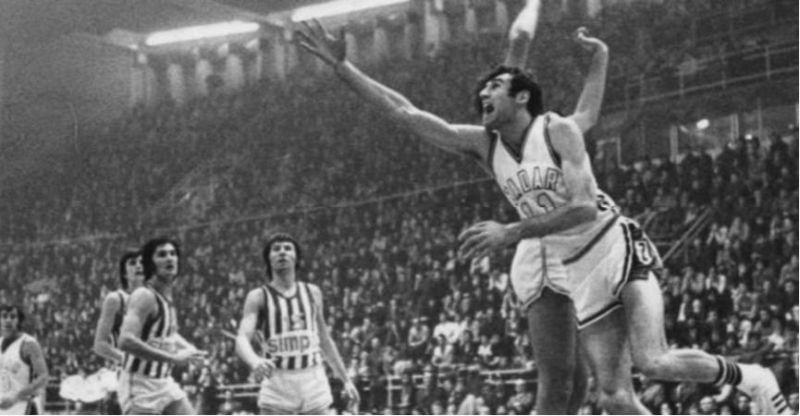
Professionally, Cosic won two more titles with Zadar in 1974 and 1975. From 1976 to 1978, he was a player-coach with Olimpija Ljubljana with no titles. Before the 1975-1976 season began, Cosic wanted to sign and play for Olimpija in Ljubljana. However, Zadar didn't want to lose Cosic to a rival so they had the Yugoslavian Basketball Federation block him from playing for Olimpija that season.
Cosic, not being a person that backs away from his ambitions, signed with Olimpija as their coach for that season, while still honoring his player contract with Zadar. In 1975, you didn't have an easy road system between Zadar and Ljubljana to drive on - at best, the quickest you could get between the two cities was seven hours.
Cosic would make the drive, run practice, coach the team, stay with basketball friends like Borut "Taubi" Bassin and his family, and then drive back. When the two teams played each other, it was a marvel to see how Cosic navigated through the situation. When I spoke with Luka Bassin (son of Tuabi and current assistant coach with Ilirija Ljubljana), the one word he used to describe this feat was "remarkable". I think if Bill Russell knew of Cosic's feat that season he would probably use the same word.
In 1978 Cosic joined Synudine Bologna in Italy and turned the team into a double-champ in the Italian league overnight, averaging 16.9 points, 9.9 rebounds, and 1.6 assists. When the Cibona club team started up in Zagreb in the early 1980s, the team owner wanted Cosic to be the key player to build around. Smart move by the owner.
In 1982, Cibona won in Brussels at the Cup Winners’ Cup against Real Madrid in overtime 96-95, with Cosic dropping 22 points. Cibona also won its first Yugoslavian League title in 1983 and also made its debut against top European competition. The 1983-84 season would be Cosic's last, with Cibona going 0-10 in European competition, Cosic always thinking ahead pushed ownership to sign a young Croatian guard by the name of Drazen Petrovic in the summer of 1984. This signing greatly helped improve Cibona in the years to come.
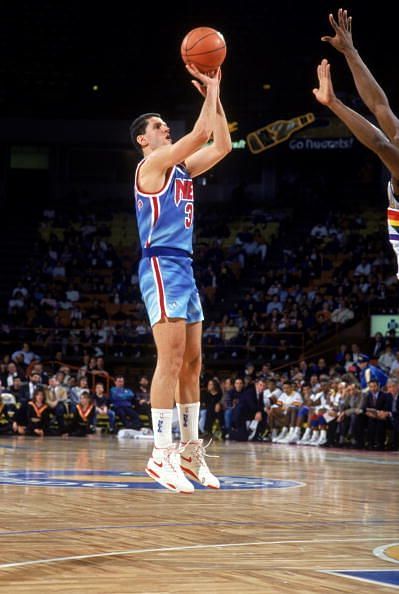
Upon retirement, Cosic jumped right into his second passion: coaching. Right away he was named coach of the Yugoslavian national team. Cosic would go on to mentor and develop Petrovic and this young center from the Serbian city of Kraljevo named Vlade Divac, plus Toni Kukoc, Dino Radja, and Aleksandar Djordjevic.
All of these players and others who played on the national teams coached by Cosic had an impact on basketball worldwide in the decades to come. Cosic was also impactful in terms of how he used his players and how he built his roster.
His rosters where full of positional versatility, he never had a roster with a traditional back to the basket center or a "true" point guard who was just a facilitator. He wanted a roster only made up of six guards and six forwards that would play fast and fluid. Like him, he expected and trained his centers to be forwards who could shoot from the perimeter, drive to the basket, pass like a point guard and rebound like giants.
He expected guards to defend both size and speed, shoot from anywhere, handle, pass and take plus make 3pt shots over lay-ups in fast-break situations. This type of team and skill building matches a lot of what you presently see in the NBA.
Cosic would step down from coaching after the six republics that made up Yugoslavia became separate and new nations again. He would return to the United States as a Croatian diplomat to once again serve his beloved Croatia and spend the last years of his life in the United States before he passed away from non-Hodgkin's lymphoma.
In Zadar, they erected a statue in his honor and later on, the new basketball arena would bear his name. The Croatian Cup is also named after him "Kresimir Cosic Cup". If you ever go to the Mirogoj cemetery in Zagreb, you will find Cosic's grave and if you walk a few meters away you will also find Petrovic's grave.
Kresimir Cosic, a legendary player on the court that turned down what might have been a Hall of Fame career in the NBA, a chance to play with some legendary NBA players, plus win NBA titles and possibly change the history of the league all to follow his heart and serve his country in legendary ways.